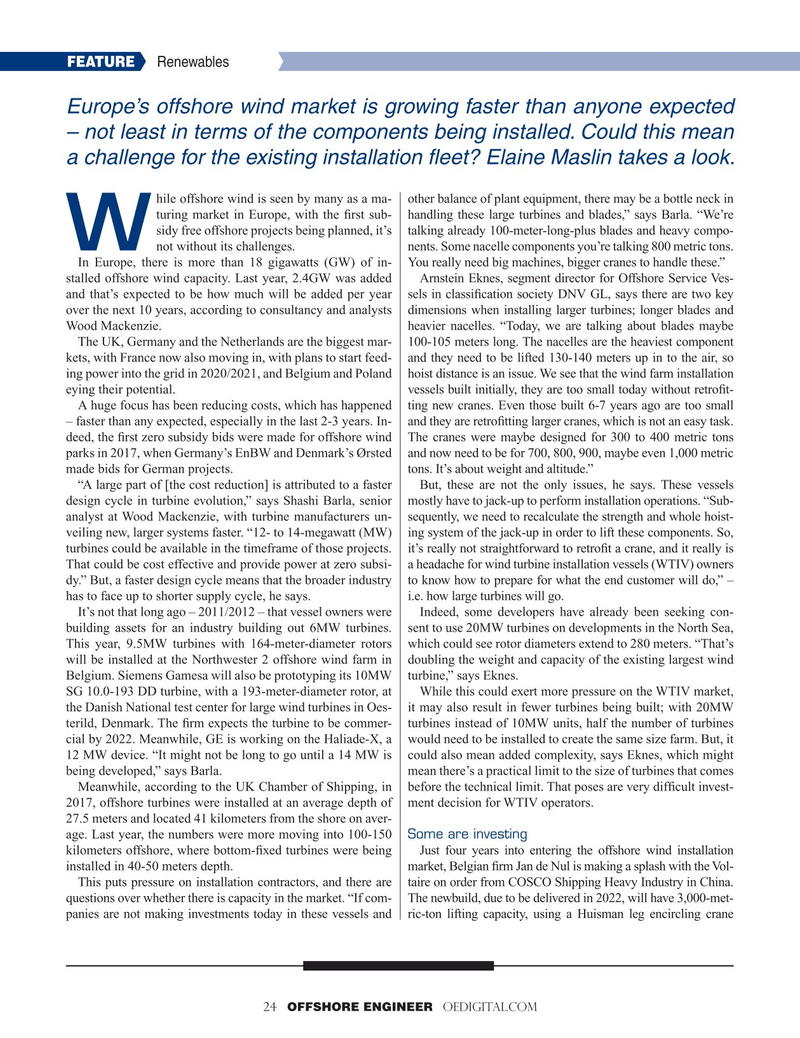
Page 24: of Offshore Engineer Magazine (May/Jun 2019)
Offshore Renewables Review
Read this page in Pdf, Flash or Html5 edition of May/Jun 2019 Offshore Engineer Magazine
FEATURE Renewables
Europe’s offshore wind market is growing faster than anyone expected – not least in terms of the components being installed. Could this mean a challenge for the existing installation ? eet? Elaine Maslin takes a look. hile offshore wind is seen by many as a ma- other balance of plant equipment, there may be a bottle neck in turing market in Europe, with the ? rst sub- handling these large turbines and blades,” says Barla. “We’re sidy free offshore projects being planned, it’s talking already 100-meter-long-plus blades and heavy compo-
W not without its challenges. nents. Some nacelle components you’re talking 800 metric tons.
In Europe, there is more than 18 gigawatts (GW) of in- You really need big machines, bigger cranes to handle these.” stalled offshore wind capacity. Last year, 2.4GW was added Arnstein Eknes, segment director for Offshore Service Ves- and that’s expected to be how much will be added per year sels in classi? cation society DNV GL, says there are two key over the next 10 years, according to consultancy and analysts dimensions when installing larger turbines; longer blades and
Wood Mackenzie. heavier nacelles. “Today, we are talking about blades maybe
The UK, Germany and the Netherlands are the biggest mar- 100-105 meters long. The nacelles are the heaviest component kets, with France now also moving in, with plans to start feed- and they need to be lifted 130-140 meters up in to the air, so ing power into the grid in 2020/2021, and Belgium and Poland hoist distance is an issue. We see that the wind farm installation eying their potential. vessels built initially, they are too small today without retro? t-
A huge focus has been reducing costs, which has happened ting new cranes. Even those built 6-7 years ago are too small – faster than any expected, especially in the last 2-3 years. In- and they are retro? tting larger cranes, which is not an easy task. deed, the ? rst zero subsidy bids were made for offshore wind The cranes were maybe designed for 300 to 400 metric tons parks in 2017, when Germany’s EnBW and Denmark’s Ørsted and now need to be for 700, 800, 900, maybe even 1,000 metric made bids for German projects. tons. It’s about weight and altitude.” “A large part of [the cost reduction] is attributed to a faster But, these are not the only issues, he says. These vessels design cycle in turbine evolution,” says Shashi Barla, senior mostly have to jack-up to perform installation operations. “Sub- analyst at Wood Mackenzie, with turbine manufacturers un- sequently, we need to recalculate the strength and whole hoist- veiling new, larger systems faster. “12- to 14-megawatt (MW) ing system of the jack-up in order to lift these components. So, turbines could be available in the timeframe of those projects. it’s really not straightforward to retro? t a crane, and it really is
That could be cost effective and provide power at zero subsi- a headache for wind turbine installation vessels (WTIV) owners dy.” But, a faster design cycle means that the broader industry to know how to prepare for what the end customer will do,” – has to face up to shorter supply cycle, he says. i.e. how large turbines will go.
It’s not that long ago – 2011/2012 – that vessel owners were Indeed, some developers have already been seeking con- building assets for an industry building out 6MW turbines. sent to use 20MW turbines on developments in the North Sea,
This year, 9.5MW turbines with 164-meter-diameter rotors which could see rotor diameters extend to 280 meters. “That’s will be installed at the Northwester 2 offshore wind farm in doubling the weight and capacity of the existing largest wind
Belgium. Siemens Gamesa will also be prototyping its 10MW turbine,” says Eknes.
SG 10.0-193 DD turbine, with a 193-meter-diameter rotor, at While this could exert more pressure on the WTIV market, the Danish National test center for large wind turbines in Oes- it may also result in fewer turbines being built; with 20MW terild, Denmark. The ? rm expects the turbine to be commer- turbines instead of 10MW units, half the number of turbines cial by 2022. Meanwhile, GE is working on the Haliade-X, a would need to be installed to create the same size farm. But, it 12 MW device. “It might not be long to go until a 14 MW is could also mean added complexity, says Eknes, which might being developed,” says Barla. mean there’s a practical limit to the size of turbines that comes
Meanwhile, according to the UK Chamber of Shipping, in before the technical limit. That poses are very dif? cult invest- 2017, offshore turbines were installed at an average depth of ment decision for WTIV operators. 27.5 meters and located 41 kilometers from the shore on aver- age. Last year, the numbers were more moving into 100-150 Some are investing kilometers offshore, where bottom-? xed turbines were being Just four years into entering the offshore wind installation installed in 40-50 meters depth. market, Belgian ? rm Jan de Nul is making a splash with the Vol-
This puts pressure on installation contractors, and there are taire on order from COSCO Shipping Heavy Industry in China. questions over whether there is capacity in the market. “If com- The newbuild, due to be delivered in 2022, will have 3,000-met- panies are not making investments today in these vessels and ric-ton lifting capacity, using a Huisman leg encircling crane 24 OFFSHORE ENGINEER OEDIGITAL.COM

 23
23

 25
25